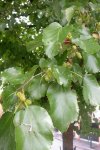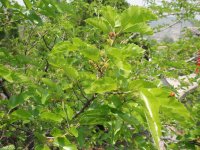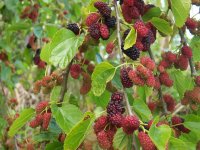Mulberry white - morus alba
Family of Mulberry (Moraceae).
Botanical characteristics. A monoecious, rarely dioecious tree with a sprawling crown up to 12-15 m. Young branches are grayish-green or brown, slightly pubescent at the ends. Leaves soft, tender, regular, petiolate, ovate, pointed, whole or 3 - 5 lobed. Flowers unisexual, collected in axillary cylindrical dense spicate inflorescences. Perianth is simple. Fruits are nuts. During the ripening of the fruit, the blossom becomes fleshy and the flowers grow together, forming an oval, 10-15 mm in length, black or white or reddish berry-like stems on an even foot. Blossoms in May, fruits ripen in July - August.
Spread. The plant is found in the wild in China and Korea. In the CIS countries it is cultivated in Central Asia, the Caucasus, Moldova, and southern Ukraine. In Russia, they are mainly grown as ornamental trees.
Chemical composition. The leaves of mulberry white contain aldehydes, steroids and their derivatives, sitosterol, organic acids (oxalic, succinic, malic, tartaric, lemon), flavonoids (quercetin, rutin, isokvetsetrin), tannins, vitamin C, carotene, essential oil.
The fruits of mulberry are rich in flavonoids, vitamins C, PP, B1, B2, carotene, organic acids (citric, malic), higher fatty acids (caprylic, enanthic, myristic, palmitic, stearic, oleic, linoleic, linolenic), essential oil, iron salts , Sugar, mainly fructose, pigments, tannins.
Used parts of the plant. For therapeutic purposes, use bark of branches, leaves, fruits, roots of mulberry white. Bark, leaves and young branches are harvested during ripening. The roots are excavated in early spring or late autumn after the cessation of sap flow.
Application in medicine
In folk medicine, plant preparations are known as general restorative, hypoglycemic, anti-inflammatory, antiseptic, hematopoietic, expectorant, diuretic, wound healing.
Tea from the leaves of mulberry white drink with beriberi, anemia, overfatigue, diabetes.
Fresh fruits activate the blood, therefore, are useful in anemia associated with gastritis, promote a normal metabolism. Use fruits with jaundice, dysbiosis, diabetes, enteritis, pancreatitis, myocarditis, heart disease.
The bark of mulberry roots is used in gastric colic as a laxative, antitussive and expectorant. Effective in hypertensive disease, bronchitis, bronchial asthma, and the trunk of the tree trunk - for wound healing, with cardiovascular diseases.
From the powder of dry leaves, an ointment is prepared based on butter, which is applied in case of skin tuberculosis, eczema, psoriasis, allergic dermatitis.
Preparation
- Infusion of fresh fruit mulberry white: 2 tbsp. L. Fresh mashed fruits pour 1 cup of boiling water and insist in a thermos for 4 hours, filter. Drink a quarter cup 4 times daily before meals with anemia, impotence diabetes mellitus.
- Broth of the bark of the roots of mulberry white: 1 tsp. Dry crushed raw materials are poured with 2 cups of boiling water and boiled for 10 minutes, insist 30 minutes, filter. Take 0.5 cup 4 times daily before meals with intestinal colic, cough, hypertension, bronchial asthma, bronchitis.
- Infusion of mulberry leaves white: 2 tbsp. L. Dry crushed leaves pour 2 cups of boiling water and insist 30 minutes, filter. Take 0.5 cup 4 times daily before meals with diabetes, avitaminosis, anemia, overfatigue, after radiation damage.
- Juice from mulberry fruits white: Fresh fruits are washed, let the water drain and rub with a wooden pestle. Squeeze the juice. Mix a quarter of a glass of juice and the same amount of water. Use a solution for rinsing the mouth with periodontal disease, stomatitis.
- Ointment from leaves of a powder of a mulberry white: Leaves wash, give water to drain and dry up. Dry leaves are ground into a fine powder and kneaded on the basis of butter ointment, observing the ratio of components 1: 1. Used externally for allergies, eczema, psoriasis, skin tuberculosis.






Comments
When commenting on, remember that the content and tone of your message can hurt the feelings of real people, show respect and tolerance to your interlocutors even if you do not share their opinion, your behavior in the conditions of freedom of expression and anonymity provided by the Internet, changes Not only virtual, but also the real world. All comments are hidden from the index, spam is controlled.